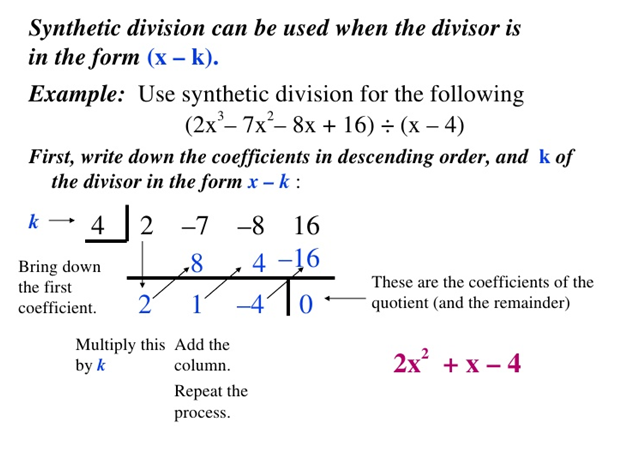Section 4.2 - Polynomial Division
Section Objectives
- Find the zeros of a polynomial and determine their multiplicities.
- Carry out polynomial long division and synthetic division.
- Apply the remainder and factor theorems.
Polynomials
An -th-degree polynomial in the variable is a function of the form
,
where the coefficients , , , are real or complex numbers with . (For this course, we will mostly be interested in polynomials with real coefficients.)
The zeros of a function are those -values for which . The real zeros of correspond to the -intercepts of the graph of : if the number is a zero of , then is an -intercept of the graph.
To find the zeros of a polynomial function, we must solve a polynomial equation of the form
General polynomial equations are often solved by first making one side of the equation equal to zero. After doing so, the next steps may vary depending on the nature of the polynomial. For now, we will focus on solving by factoring.
Factored polynomials and zeros
When a polynomial is completely factored, the number of times a specific linear factor occurs in the factorization is called the multiplicity of the corresponding zero.
Examples
- has zeros , , and , with multiplicities 3, 1, and 2, respectively.
- Let . Find the zeros of and their multiplicities. (Solution)
Polynomial division
As long as you don't try to divide by zero, any two whole numbers can be divided to obtain a quotient and a remainder. For example, .
In a similar way, a polynomial can be divided by a nonzero polynomial to form a quotient and remainder. In fact, given any polynomials and , there are unique polynomials and such that
where or the degree of is less than the degree of .
The quotient and remainder can be obtained by carrying out polynomial long division. In your end result, the degree of the remainder must be less than the degree of the divisor.
The steps for polynomial long division can be found here. For another look, with some animations, try here.
Examples
- Use long division to divide: (Solution)
- Use long division to divide: (Solution)
VERY IMPORTANT IDEA: When the polynomial is divided by , the remainder is the value . This idea often goes by the name of the Remainder Theorem.
Examples
- Let . Use division to compute . (Solution)
- Let . Use division to compute . (Solution)
Synthetic division
When a polynomial is divided by a 1st-degree polynomial of the form , the long division process can be streamlined into a very efficient procedure called synthetic division.

When using synthetic division, you must keep the following points in mind:
- Our form of synthetic division applies only when dividing by a polynomial of the form , where can be any real or complex number.
- Be sure to write the coefficients of the dividend in order of descending exponents, including any missing zero coefficients.
- Be sure to use the correct sign of .
- The number at the far right of the bottom row of your finished tableau is the remainder.
Examples
- Use synthetic division to divide: (Solution)
- Let . Use synthetic division and the remainder theorem to compute . (Solution)
VERY IMPORTANT IDEA
Factor Theorem: is a factor of the polynomial if and only if is a zero of .
Examples
- If a polynomial has zeros , , and , then it must have the corresponding factors , , and .
- Determine if is a factor of . Do you notice another factor? (Solution)
For further help...
There are lots of resources available to help you with polynomials and division.
- Steps for polynomial long division can be found here or here.
- Do a Google search for "polynomial long division". Among other things, you will find some good Khan Academy videos and lots of images of worked-out examples.
- There is an actual long division calculator.
- Do a Google search for "remainder theorem". You will find some good Khan Academy videos.
- Do a Google search for "factor theorem".
- Go a Google search for "synthetic division". You will find videos and lots of examples.
- There is also a synthetic division calculator.